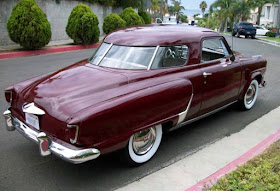And as I posted here, other car makers followed as quickly as they could manage to do so. Most Chrysler Corporation brands got them for 1950. Ford, Hudson and Packard launched theirs for 1951. The following model year, 1952, brought in most of the laggards: Mercury, Lincoln, Nash and Studebaker.
All of the 1952 class except Studebaker had to wait until then because they got redesigned bodies for '52. Their previous bodies were not suited for incorporating convertible-like cars with metal tops, whereas their redesigned bodies had hardtops in mind from the start.
Studebaker is an interesting case because management dithered, finally allowing a hardtop model for the final year of its 1947 body. That is, that particular model was only in production for one model year, an economically risky proposition given tooling costs. Richard Langworth briefly dealt with the 1952 Starliner (as it was called) here, pages 50-51.
The Starliner coupe was an attractive addition to Studebaker's line, as can be seen below. Images are via the automobile consignment firm Streetside Classics unless otherwise noted.
A fine photo via Wikipedia that I used in the second link above. The roofline and windows are based on the 1949 GM version, though had to be adapted to Studebaker's sloping rear deck.
For context, a McCormick's auction photo of a 1952 Starlight coupe, Studebaker's previous mainline sporty model. The Starliner was more closely related to the firm's convertibles, however, due to the need for a truncated B-pillar and two roll-down side windows.
In model year 1952 Studebaker lost its airplane-inspired frontal styling as it transitioned to the sensational forthcoming 1953 redesign. The two-segment grille hints at the '53s.
The camera's wide-angle lens slightly exaggerates slopes of the hood and rear deck.
The central segment of the backlight would have looked better if its upper edge was straighter.
Close-up view of the new grille. That white spot shown above the hood is actually a reflection off the windshield, and not part of the car.






The last front end on this body besides being a precursor to what they knew was coming next was also a throwback to the original front end of this body. Back to normal. Sans central propeller the original Karman Ghia front end has something of the basic idea of the '51-'52 Studebaker, and other Italian styled sporty cars of the era as well.
ReplyDeleteThe '52 Studebaker body, with roots going back to 1946, had a lot of construction elements that by then were way out of date - the pasted on rear fenders, the extra bit of body ahead of the front door between the door and front fender, and on four doors another extra vertical bit between the doors. Also the ventilation doors that opened on the side of each front fender, which must have cost a bunch of dollars more than other arrangements. No one had settled on cowl slots with drainage yet. Chrysler products still had a cowl air intake that required levering open in their '55-'56 body.
I don't think Studebakers ever got ball joint front suspensions. Larks were still on straight frames from 1953 (probably basically from 1946) at the end in 1966, when Ford got a frame enabling rear seat floor wells in 1957 and Chevy in 1958, and Chryslers got unit bodies permitting front and rear footwells in 1960.
ReplyDeleteStudebaker Larks eliminated the side vent doors. I think the intake was in the little grilles next to the headlights - still costing more than cowl slots. They never got the cowl slots everyone else had. I have no idea where fresh air came from after the little grilles went away.
A well managed company might have come up with money for an actually modern car at some point back then, and stiffed the workers to get costs down to equal others. I think all the independents were kind of hidebound and traditionalist in the 50's when modern management was called for. They should have combined in about 1952 and got on with it.
emjayay- Studebaker did get cowl air slots as I own a 1964 Daytona and it has fresh air coming in the cowl. Can't remember if 63 had them. Footwells were NOT the cat's whiskers. Ball joints for all they are touted to be to this day, were and are not a strong as the Stude kingpin setup. That front suspension system could take a beating that made the big 3 systems wilt.
ReplyDelete